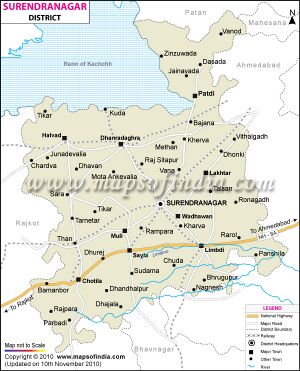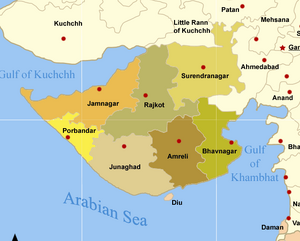Wadhwan
| Author:Laxman Burdak, IFS (R) |

Wadhwan (वढवाण) is a city in Surendranagar district in the Indian state of Gujarat. It is an ancient historical and religious place located in Kathiawar region of Gujarat.
Location
It is located about 111 km from the town of Ahmedabad, some 3 km distant from Surendranagar city. The town is situated on the banks of the Bhogavo River.
Variants
- Wadhwan (वाधवां), कठियावाड़, गुजरात (AS, p.620)
- Bandhavan बांधवां, कठियावाड़, गुजरात (AS, p.620)
- Vardhamanapura वर्धमानपुर, कठियावाड़, गुजरात, (AS, p.836)
- Vadhwan (वढवाण)
- Vardhamanpuri/Vardhamanapuri (वर्धमानपुरी)
- Vadhavan वाधवां दे. Vardhamanapura वर्धमानपुर, (AS, p.840)
History
R.C.Majumdar[1] writes that....Mr. K. B. Pathak brought to light a passage in Jaina Harivamsa of Jinasena which gives the precise date of its composition. The passage was subsequently noticed by Peterson and Fleet (Ep, Ind., Vol. VI, pp, 195.6) and the following remarks of the last named scholar may be taken to fairly represent the views of all the three regarding its interpretation. " A passage in Jaina Harivamsa of Jinasena tells us that the work was finished
[Page-24] in Saka-Samvat 705 (expired), = A. D. 783-784, when there were reigning, in various directions determined with reference to a town named Vardhamanapura (वर्धमानपुर), which is to be identified with the modern Wadhwan (वढवाण) in the Jhalawar division of Kathiawar, in the north, Indrayudha ; in the south Srivallabha ; in the east, Vatsaraja, king of Avanti (Ujjain); and, in the west, Varaha or Jayavaraha, in the territory of the Sauryas."
Vadhwan rulers belonged to the Jhala clans. The town of Vadhwan was fortified and gates were erected at most places to provide safety. Some of these gates and the fortified walls are still found in the city. Vadhwan was the centre of the princely state by the same name, which in earlier days was known as Vardhamanpuri, the name being derived from the great Jain Thirthankaras, Bhagwan Vardhaman.
The prime ministers of this princely state belonged to the Rawal family who were given the title of Dewan Bahadur. Under their rule, a number of important structures were constructed, mostly during the era of 18th and 19th century. Vadhwan is considered as an important centre for Jains and is renowned as one of the fortified towns of Gujarat.
Formerly known as Vardhamanpuri, the town is believed to have footprints of Lord Mahavir. The Raj Mahal and Hawa Mahal were constructed here by the erstwhile rulers of the region. Hawa Mahal, "the wind palace" was built during the era of Jhala rulers.
Vadwala Temple here is some 450 years old. 11th century Gangva Kund at Dedadara village is believed to have been constructed during the Chalukya period.
The popular ancient Gangavav step-well is believed to have been constructed in Vikram Samvat in 1969. There is Lakhavav also.
Madhavav is popular stepwell for its historical significance. It is believed that the son and daughter-in-law of King Sarang Dev sacrificed their lives here for the natives of the region. The
During the British Raj, Wadhwan State was one of several princely states governed by the Jhala Rajput. It was classified as a 9-gun salute state.[2]
बांधवां, कठियावाड़, गुजरात

विजयेन्द्र कुमार माथुर[3] ने लेख किया है .....बाँधवाँ (AS, p.620) काठियावाड़, गुजरात के प्राचीन नगरों में से एक है। इस नगर को पहले 'वर्धमानपुर' कहा जाता था। यह अन्हिलवाड़ (वर्तमान पाटण) से जूनागढ़ जाने वाले मार्ग पर स्थित है। मध्य काल में यह नगर जैन धर्म तथा विद्या का केंद्र था। बाँधवाँ के जैन विद्वानों में ऐतिहासिक ग्रंथ 'प्रबंध चिंतामणि' के रचयिता मेरुतुंग आचार्य प्रसिद्ध हैं। इस ग्रंथ का रचनाकाल 1305-1306 ई. है। इसमें गुजरात के प्राचीन इतिहास का वर्णन है। इस ग्रंथ का अनुवाद [p.621]: प्रो. एच. टॉनी ने किया है। वर्धमानपुर का नाम जैन तीर्थंकर वर्धमान महावीर के नाम पर प्रसिद्ध हुआ था।
वर्धमानपुर
वर्धमानपुर, कठियावाड़, गुजरात, (AS, p.836): झालावाड़-प्रदेश के अंतर्गत वर्तमान वाधवां. जैन हरिवंश की तिथि के बारे में लिखते हुए जिनसेन ने इस नगर का उल्लेख किया है.[4]
External links
References
- ↑ R.C.Majumdar: "The Gurjara Pratiharas", Journal of the Department of Letters Vol.X, Calcutta University Press, 1923,p.23-24
- ↑ McLeod, John (1999). Sovereignty, Power, Control: Politics in the States of Western India, 1916-1947. BRILL. pp. 8–9. ISBN 9789004113435.
- ↑ Aitihasik Sthanavali by Vijayendra Kumar Mathur, p.620-621
- ↑ Aitihasik Sthanavali by Vijayendra Kumar Mathur, p.836

